To the reader:
The essay below, on the ballet school scene from August Bournonville’s Konservatoriet (The Conservatory), was commissioned by the Royal Theatre in Copenhagen, Denmark. It first appeared, translated into Danish by Lise Kaiser, in the Royal Danish Ballet’s illustrated program in Spring 2011. The original English version appears here for the first time with the gracious permission of the Royal Theatre.
August Bournonville (1805-1879)–dancer and choreographer, instructor and artistic director–gave the Royal Danish Ballet a repertory and a dancing style that have made it, and kept it, a world-class phenomenon. As his voluminous memoir, Mit Teaterliv (My Theatre Life), reveals, several of his ballets that are alive in the repertory today were inspired by his personal experience. Konservatoriet (The Conservatory), created in 1849, is one of them.
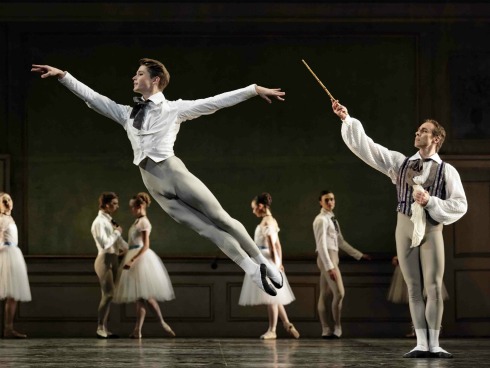
Charles Andersen (in flight) and Jean-Lucien Massot (r.) as the ballet master in the Royal Danish Ballet’s production of August Bournonville’s Konservatoriet
Photo: Costin Radu
Bournonville was trained for a career in ballet from childhood–at Copenhagen’s Royal Theatre, where his father, Antoine, was ballet master (that is, artistic director). In the 1820s, to put the finishing touch on his skills, he traveled to Paris, then the dance capital of the world. There he studied with the celebrated Auguste Vestris, who came to be known as le dieu de la danse (god of the dance). Eventually, through his talent and diligence, the young Bournonville progressed to performing with the Paris Opera Ballet, even partnering the most celebrated ballerina of the Romantic age, Marie Taglioni.
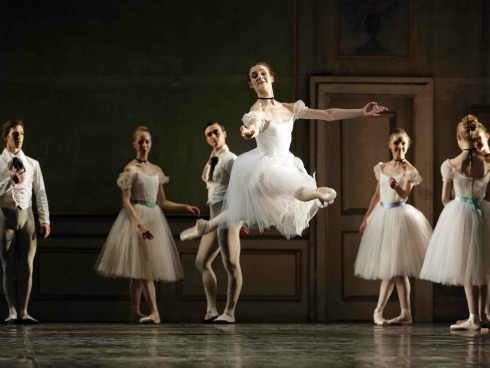
Diana Cuni in flight in Konservatoriet
Photo: Costin Radu
After distinguishing himself abroad, Bournonville returned to Denmark to rescue the Royal Danish Ballet from an arid period and to rejuvenate it. But through a long career as ballet master in Copenhagen, he never forgot his experience in Paris. Some two decades after his return home, just after he retired from performing, he immortalized in Konservatoriet his memory of the classroom of those early days. Music–both borrowed and composed–by Holger Simon Paulli evoked the scene, as did the women’s filmy white tutus, emblems of Romantic-era dancing.
The setting of Konservatoriet is one common to ballet studios everywhere–an uncluttered space. In today’s renditions, the scenic design omits even the ornate pictures on the walls in the original version. Now only a single decorative element signals the grandeur of Parisian ballet–a crystal chandelier, albeit one that’s swathed in gauzy fabric to keep off the dust during the day, when the theater’s routine work takes place.
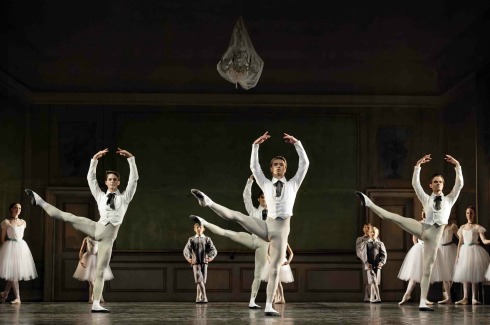
(L. to r.) Charles Andersen, Gregory Dean, and Alexander Staeger, with pupils of the Royal Danish Ballet’s school behind them, in Konservatoriet
Photo: Costin Radu
The studio is peopled by a ballet master who directs the daily class and dances as well; a bevy of freshly minted adult dancers, two of the women obviously favorites–by virtue of their talent and charm; a handful of children who are being trained for the stage by taking class alongside their role models; and a violinist to accompany them all in their exertions.
The choreography Bournonville devised for these characters has an architecture that is impeccably ordered, varied, and balanced. Viewers may absorb this great virtue only subliminally because of the vitality and beauty of what is right before their eyes: the duets and trios, the solos that sometimes hint at a particular personal quality, and the small groups that sweep across the floor one after the other, as if they were impelled by the dancers’ camaraderie. And of course the children have their little moment in the sun. Audiences are invariably enchanted by the immature bodies’ precocious technical aplomb.
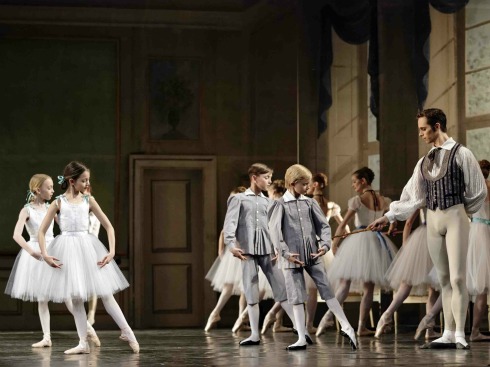
Children of the Royal Danish Ballet’s school with Nicolai Hansen as the ballet master in Konservatoriet
Photo: Costin Radu
Bournonville’s deftness in turning the commonplace practices of the classroom into theatrically fascinating material is everywhere apparent. Example: The ballet master summons first one of his protégées (demonstrating that he wants her to begin with the backbend phrase of a sequence he has no doubt taught her), then the other. The two proceed to execute the same bit of choreography, but with the second woman a phrase behind the first. So, when a leg is extended hip-high by one and then the other, both women turning in place, the pair creates the hypnotic effect of a pair of windshield wipers gone out of synch. As if by magic–you can’t catch how it’s done–they end by working in unison.
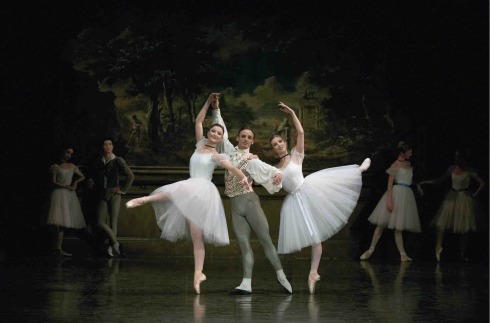
Thomas Lund, flanked by Gitte Lindstrøm (l.) and Gudrun Bojesen (r.) in Konservatoriet
Photo: Martin Mydtskov Rønne
At the heart of the work is a dance for three–the ballet master and the two “special” young women, who fleetingly hint both at sweet sisterhood and competitive rivalry. Its various solos, duets, and trios are connected so naturally they look joined by happenstance–or, more likely, inevitability.
One of the many marvels in the ballet school scene is its opening. It’s no accident that Konservatoriet begins and ends with the same basic step–a grand plié–that a dancer does, many times over, every day of his or her dancing life. It makes for stretch and suppleness and, done without support as it is here, is a challenging test of balance. The curtain rises on a view of the performers neatly aligned in rows, facing the audience. In unison, they take one step forward, then–legs and feet “turned out” so that their kneecaps face opposite sides of the stage–bend their knees and smoothly, torso erect, head exquisitely poised, lower their bodies towards the floor. And, still without a tremor, rise again.
The ballet finishes with the same action, this time adding a single flourish–the sudden flaring of one leg into a curved position behind the body while the opposite arm is raised in a complementary arc. The pose recalls statues by the Renaissance sculptor Giovanni da Bologna that inspired the use in ballet of this sublimely balanced position. The figure represents Mercury, messenger of the gods.
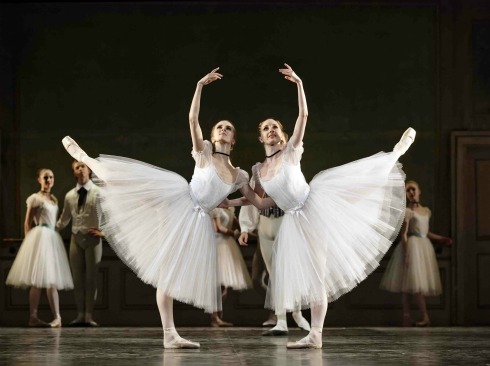
Susanne Grinder (l.) and Kizzy Matiakis (r.) as the prize young women of their class in Konservatoriet
Photo: Costin Radu
Konservatoriet is danced in the unique style that Bournonville developed for his dancers. To this day there has been no classical dance company in the world that can equal the Royal Danish Ballet in its specialties.
Notice, for instance, the way these dancers look when they travel horizontally through the air. Their leaps don’t take the swift, straight path of an arrow or bullet; rather, they’re buoyant, like feathers blown by an April breeze.
Notice, too, the quick, crisp footwork. On the women it looks positively filigreed. Wherever possible, jumps are festooned with beats of one foot against the other, executed immaculately and at hummingbird speed. Viewers keeping close watch will marvel at the fact that, on the landings, just for a split second, the turned-out feet snap shut–right heel against left toes, left heel against right toes–as uncompromisingly predatory as a shark’s jaws, the exactitude and energy of that action helping the dancer rebound into the air.
Above the waist the head, neck, and shoulders continuously shift position, gently, to complement the formidable work of the legs and feet. The torso is pliant but calm; the arms, often held low and still.
Bournonville’s choreography requires dancers who, within even a brief passage, can alternate slow and fast movement, perform difficult steps with equal panache to both right and left, and spring into any direction at all without the slightest hint beforehand of which way that will be.
Dancers often say that Bournonville style demands a killer technique, especially because the performer must behave as if everything were perfectly easy. What’s more, the choreography must be offered to the audience with a friendly, modest demeanor in which there’s not a single thing that’s fake. And whatever group is on the stage at a given time, all its members must present themselves as part of a heartfelt community. To dance according to Bournonville’s values is to create a metaphor for civilized conduct.
The Konservatoriet we know today was not, at first, a stand-alone ballet. As its original title indicated, it was longer–Konservatoriet, eller Et Avis Frieri (The Conservatory, or A Proposal of Marriage Through the Newspaper). A lightweight but appealing plot, bubbling with gaiety and requiring eloquent mime, was wrapped around the ballet class scene.
Monsieur Dufour, a late-middle-aged, bumbling yet self-congratulatory administrator of the leading ballet academy in Paris, has half-promised to marry his faithful housekeeper. Nevertheless hoping for a more glamorous match, he places an advertisement in a newspaper personals column. Seeing this, the academy’s students inveigle him into an evening at a restaurant with an outdoor space for dancing, a peaceable view of nature, and a huge and varied clientele. There, amidst much fun his expense, Dufour learns to accept reality.
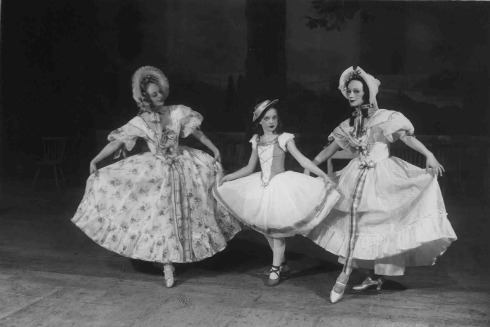
The very young Kirsten Ralov as the aspiring child, Fanny, flanked by Else Højgaard (l.) and Margot Lander (r.) as the budding ballerinas who befriend her
Photo: Huset Mydtskov, 1933
Meanwhile little Fanny, the daughter of impoverished street musicians, longs to get the serious dance training her native talent deserves but is turned down by Dufour because she can’t pay for lessons. The academy’s two budding ballerinas “adopt” her cause and see to it that her future is assured.
By the mid-1930s, the time of the full-length Konservatoriet had come and gone; in 1941 the ballet class segment began to be performed independently. In 1995 the complete version was revived by a trio of seasoned Bournonville experts that included Kirsten Ralov–a Royal Ballet stalwart as dancer, instructor, and administrator–who had danced the role of Fanny as a child. While the revival had its charm–and, certainly, historical interest–it didn’t appeal to today’s audience. However, the classroom scene continues to thrive, describing with affection what ballet was like in early-nineteenth-century Paris.
Konservatoriet offers far more than nostalgia, though. It indicates how Bournonville absorbed the crystalline precision of the French style of dancing and quietly adapted it to the humane values of Danish culture. Even so, he was not merely adept. It was his unique genius–inborn, rare, impossible to explain but easy to recognize–that allowed him to create this gleaming ballet about classical ballet, which reveals the very foundations of the art.
Tobi Tobias writes a weekly column on dance, SEEING THINGS, for ArtsJournal (www.artsjournal.com/tobias). For her work on Bournonville and the Royal Danish Ballet, she was honored with a Danish knighthood.
© 2011 Tobi Tobias




I have seen this ballet performed now three times: the first time at the glorious Bournonville Festival in 2005; the second in dress rehearsal at the Colon Theater in Buenos Aires (don’t ask!); and the third time five minutes ago through the clear-eyed, diamond-cutter’s precision of Tobi’s description above.
This is not the only Bournonville ballet, or if it comes to that, classical or neo-classical ballet that provides “a metaphor for civilized conduct”–Balanchine’s “Symphony in C” and “Concerto Barocco” come to mind as well, but it does it with a warmth and charm that have truly gone out of our lives. Will they ever return? Let’s hope so.
Thanks, Tobi.
Beautifully written essay. Now I understand the mystique.
. . . your lovely latest on Bournonville.
Is “today’s audience” the same as that of 1995? I ask, thinking that the “Konservatoriet” we know seems, in view of this essay, rather like “The Kingdom of the Shades”… which many balletomanes, most certainly, regard as the heart of “La Bayadere” but still not the whole shooting match. I, for one, would love to see “Et Avis Frieri” in its long form. Thanks for providing context. And also for that magnificent stop-time description of Bournonville landings. Brilliant. Illuminating.